Analysis of the Thermal Processes in an Electromagnetic Mill
Abstract
1. Introduction
2. Analysis of Recent Research
3. Structure of the Cooling System
4. Numerical Analysis
5. Research Methods
6. Results and Discussion
- Dai: inside diameter of the inductor yoke;
- Dr: inside diameter of the tube of the working chamber;
- Pcw: perimeter of the channel in the coil conductor;
- Piz: perimeter of the channel in the frame;
- lΣwo: length of the overhang of the coil;
- Sc: surface area of the frame cooling;
- Srk: surface area of the working chamber cooling.
7. Conclusions
- The replacement of the inductor core with a thermally anisotropic homogenous body reduces the size of the coefficient matrix for the calculation of the temperature field due to a significant reduction in the detail of the computational area. At the same time, the accuracy of the calculated temperature values is virtually unchanged.
- The equivalent coefficients of thermal conductivity, assuming a one-dimensional heat distribution in the EMM, used for the calculation of the parameters of thermal-equivalent schemes, ensure the accurate calculation of the mean values of temperatures of the active parts at the level of 15–20% compared to the actual values.
- Based on the comparative analysis of the results of the calculation of the mean values of the temperature of the EMM components with forced liquid cooling using the TEC and FEM analysis, it was revealed that the discrepancy in the results does not exceed 6%. This substantiates that the TEC structure selected adequately reflects the most probable ways of distributing heat flows. The methods for calculating thermal resistance based on analytical solutions of the heat conductivity equation provide satisfactory accuracy of the estimation of the EMM thermal state.
- The system of forced double-circuit liquid cooling can provide effective heat removal from active parts, which makes it suitable for use in the EMM.
Funding
Data Availability Statement
Conflicts of Interest
References
- Wolosiewicz-Glab, M.; Foszcz, D.; Gawenda, T.; Ogonowski, S. Design of an electromagnetic mill. Its technological and control system structures for dry milling. E3s Web Conf. EDP Sci. 2016, 8, 1066. [Google Scholar] [CrossRef]
- Styła, S. Examination of an electromagnetic mill structure by means of infrared radiation. Prz. Elektrotech. 2014, 90, 179–182. [Google Scholar] [CrossRef]
- Całus, D.; Makarchuk, O. Analysis of interaction of forces of working elements in electromagnetic mill. Prz. Electrotech. 2019, 12, 64–69. [Google Scholar] [CrossRef]
- Makarchuk, O.; Calus, D. Reserch of the performance indicator of an electromagnetic mill. Tech. Electrodyn. (Tekhnichna Elektrodynamika) 2022, 1, 50–57. [Google Scholar] [CrossRef]
- Kolondzovski, Z.; Arkkio, A.; Larjola, J.; Sallinen, P. Power limits of high-speed permanent-magnet electrical machines for compressor applications. Rep. Ser. Electromechanics Aalto Univ. Sch. Sci. Technol. Espoo 2010, 76, 73–82. [Google Scholar] [CrossRef]
- Nategh, S. Thermal Analysis and Management of High-Performance Electrical Machines. Ph.D. Thesis, Department of Electrical Energy Conversion, KTH Royal Institute of Technology, Stockholm, Sweden, 2013; pp. 1–137. [Google Scholar]
- Kutateladze, S.S. Heat Transfer and Hydrodynamic Resistance: Reference Manual; Teploperedacha i gidrodinamicheskoye soprotivleniye: Spravochnoye posobiye; Kutateladze, S.S., Ed.; Energoatomizdat: Moskow, Russia, 1990; p. 367. (In Russian) [Google Scholar]
- Mikheev, M.A.; Mikheeva, I.M. Fundamentals of Heat Transfer, 2nd ed.; Energy: Moskow, Russia, 1977; pp. 1–344. (In Russian) [Google Scholar]
- Kolondzovski, Z. Thermal and Mechanical Analyses of High-Speed Permanentmagnet Electrical Machines. Ph.D. Thesis, Department of Electrical Engineering, Aalto University School of Science and Technology, Espoo, Finland, 2010; pp. 1–94. [Google Scholar]
- Staton, D.; Boglietti, A.; Cavagnino, A. Solving the more difficult aspects of electric motor thermal analysis. In Proceedings of the Electric Machines and Drives Conference, IEMDC’03. IEEE International, Madison, WI, USA, 1–4 June 2003; Volume 2, pp. 747–755. [Google Scholar]
- Makarchuk, O.; Lis, M.; Gastołek, A.; Sosnowski, J. Analiza stanu cieplnego wysokoobrotowych maszyn elektrycznych o wzbudzeniu od magnesów trwałych z chłodzeniem cieczowym. Zesz. Probl. Masz. Elektr. 2015, 1, 7–15. [Google Scholar]
- Huang, Y.; Zhu, J.; Guo, Y. Thermal Analysis of High-Speed SMC Motor Based on Thermal Network and 3-D FEA With Rotational Core Loss Included. Magn. IEEE Trans. 2009, 45, 4680–4683. [Google Scholar] [CrossRef]
- ANSYS, Inc. Theory Reference, ANSYS Release 9.0, ANSYS Inc Products, Southpointe, 275 Technology Drive, Canonsburg, PA, USA. November 2004. Available online: https://www.ansys.com (accessed on 3 August 2022).
- Guo, C.; Long, L.; Wu, Y.; Xu, K.; Ye, H. Electromagnetic-thermal coupling analysis of a permanent-magnet in-wheel motor with cooling channels in the deepened stator slots. Case Stud. Therm. Eng. 2022, 35, 102158. [Google Scholar] [CrossRef]
- Chen, B.; Guan, X.; Cai, D.; Li, H. Simulation on thermal characteristics of high-speed motorized spindle. Case Stud. Therm. Eng. 2022, 35, 102144. [Google Scholar] [CrossRef]
- Sim, K.; Lee, Y.B.; Jang, S.M.; Kim, T.H. Thermal analysis of high-speed permanent magnet motor with cooling flows supported on gas foil bearings: Part I-coupled thermal and loss modeling. J. Mech. Sci. Technol. 2015, 29, 5469–5476. [Google Scholar] [CrossRef]
- Kreith, F.; Black, W.Z. Basic Heat Transfer; Harper & Row: New York, NY, USA, 1980; pp. 1–259. [Google Scholar]
- Xu, Y.; Zhang, B.; Feng, G. Electromagnetic design and thermal analysis of module combined permanent magnet motor with wrapped type for mine ball mill. IET Electr. Power Appl. 2022, 16, 139–157. [Google Scholar] [CrossRef]
- Styła, S. Analysis of temperature distribution in electromagnetic mill. Prz. Elektrotech. 2016, 92, 103–106. [Google Scholar] [CrossRef]
- Makarchuk, O.V. Additional losses in the stator windinds of the high-speed brushless electrical machine with the permanent magnets. Sci. Bull. Natl. Min. Univ. 2016, 6, 107–113. [Google Scholar]
- Borisenko, A.I.; Kostikov, O.N.; Yakovlev, L.I. Cooling of Industrial Electric Machines; Energoatomizdat: Moskow, Russia, 1983; pp. 1–296. (In Russian) [Google Scholar]
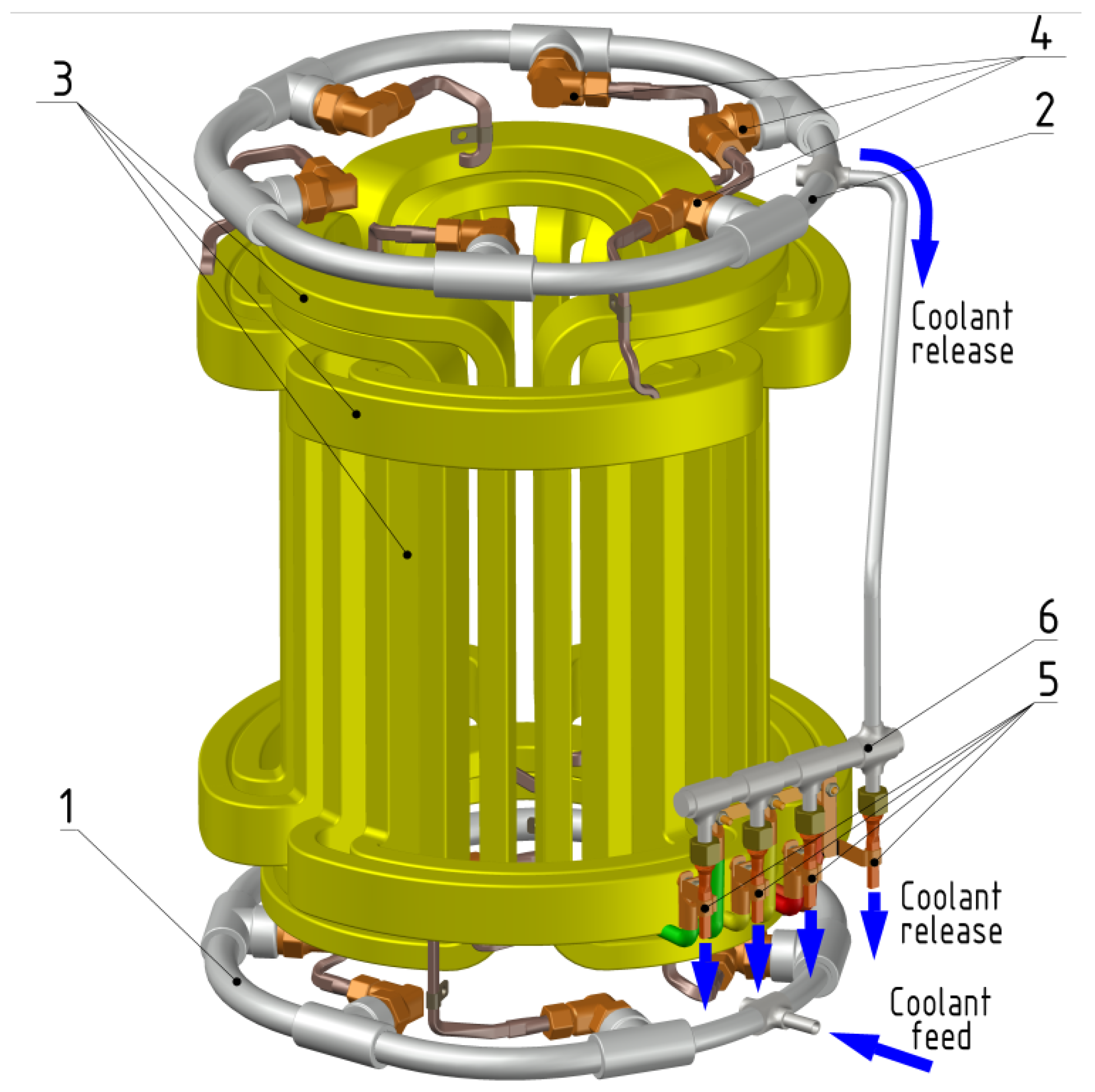
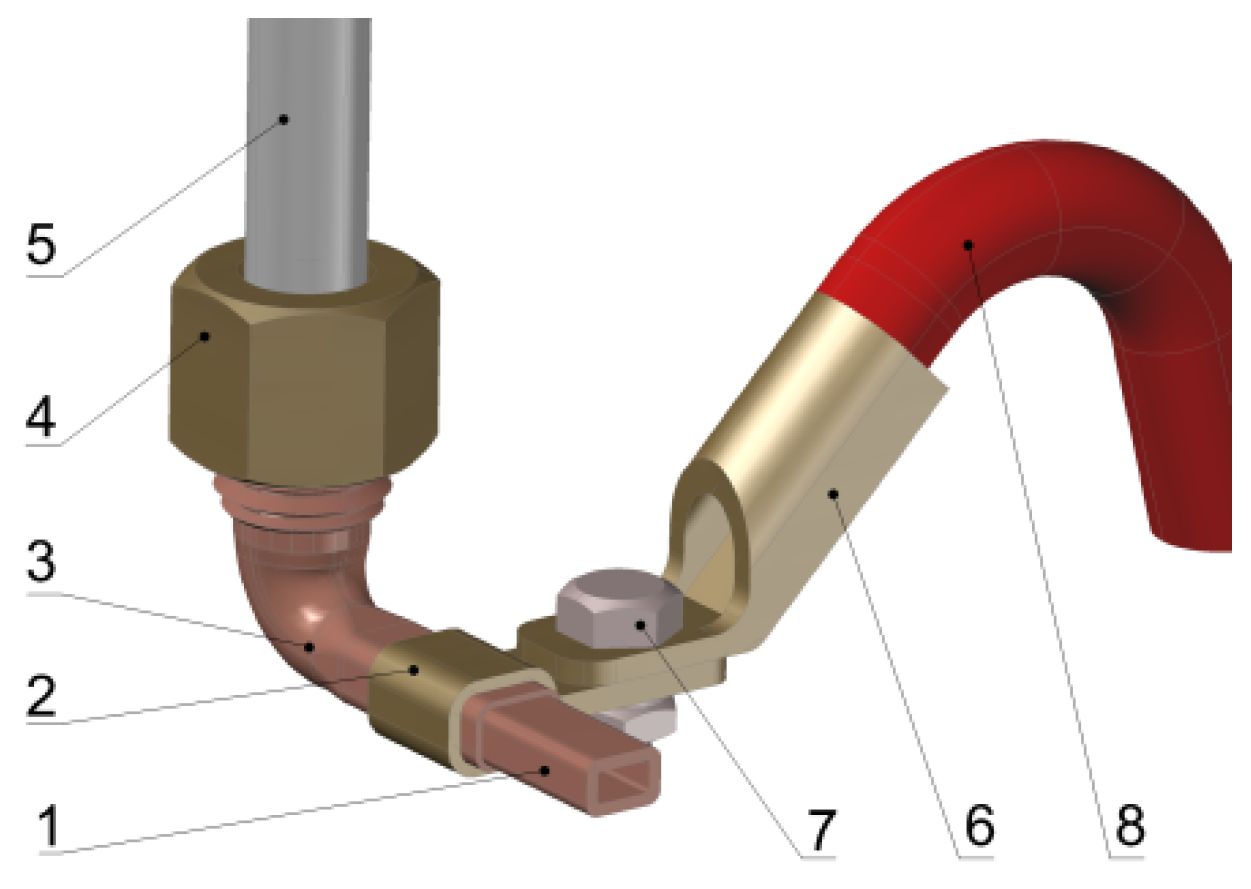
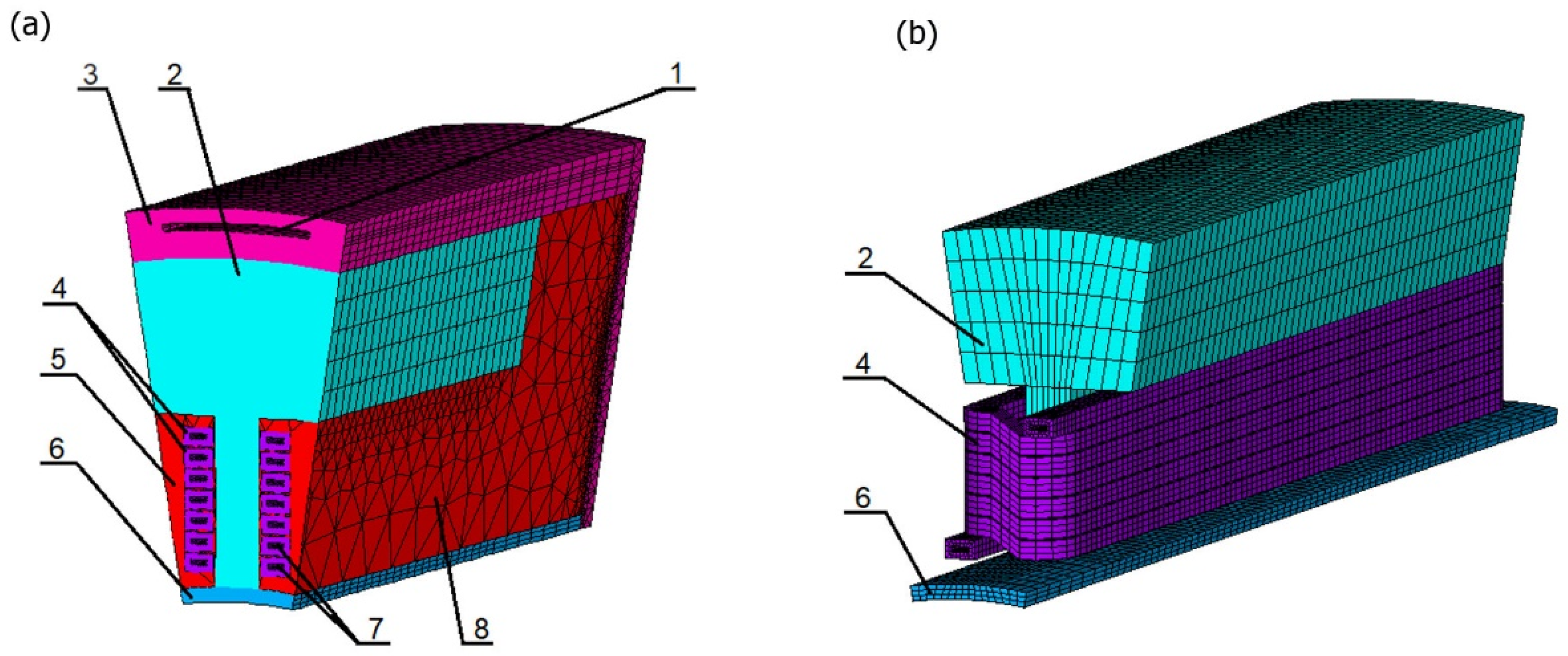
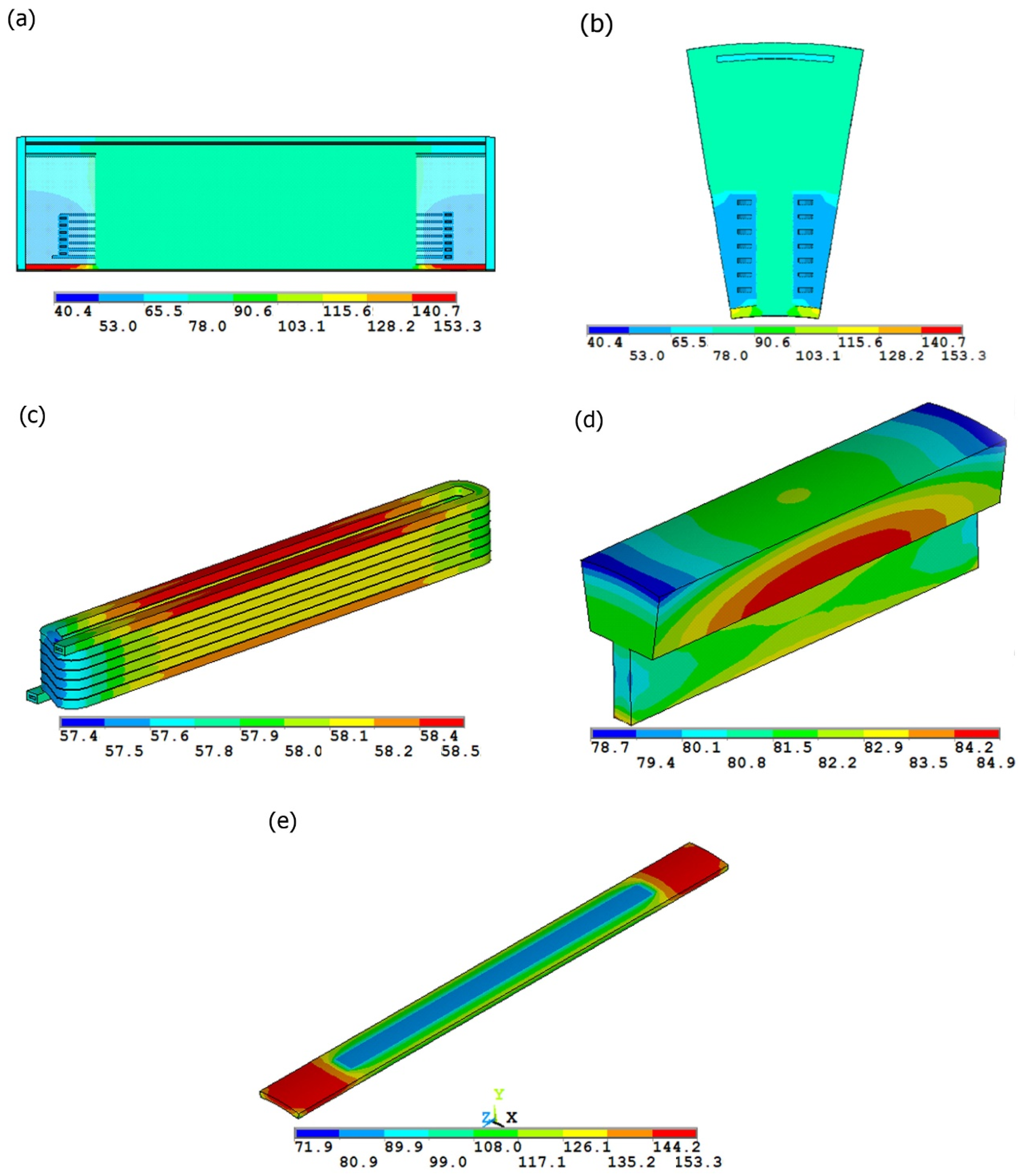
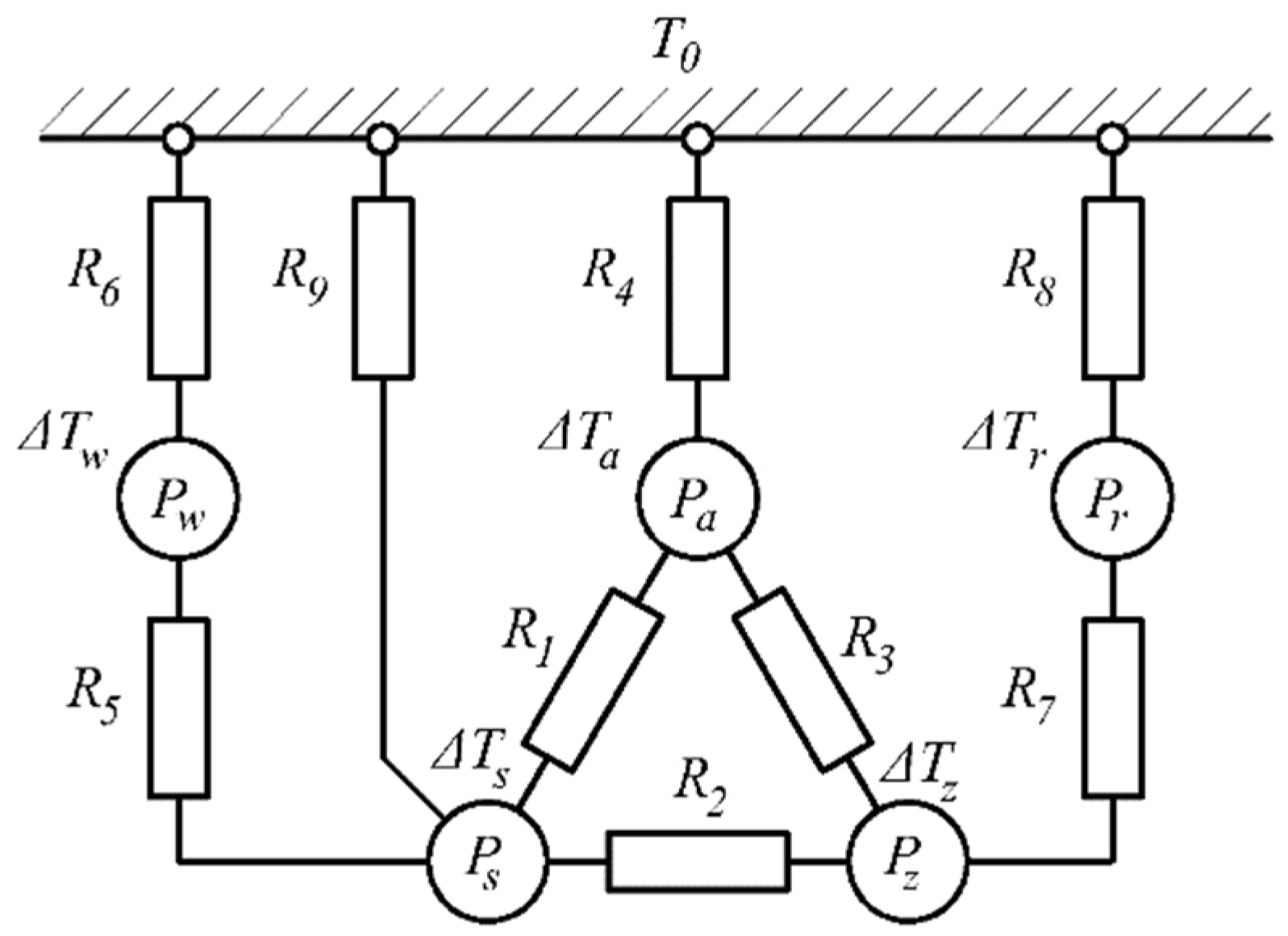


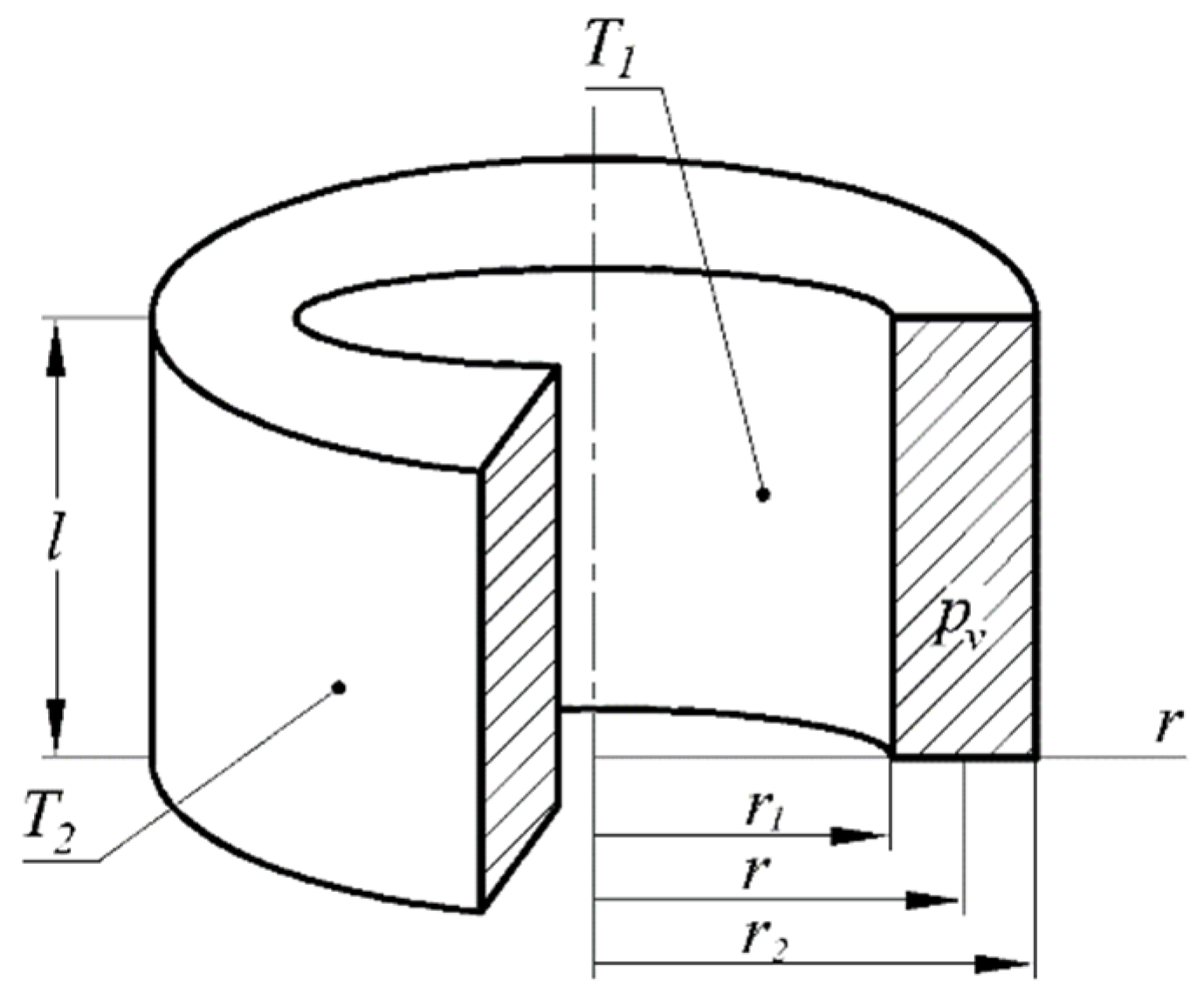
| Name | Symbols | Value |
|---|---|---|
| 1 | 2 | 3 |
| Main EMM electrical indicators | ||
| phase voltage, V | - | 100 |
| phase current, A | - | 324 |
| power supply frequency, Hz | - | 50 |
| consumed power, W | - | 9000 |
| power coefficient | - | 0.09 |
| Power loss, W | ||
| slot of the inductor winding | Ps | 2198 |
| overhang of the inductor winding | Pw | 2805 |
| tooth of the inductor core | Pz | 15.61 |
| yoke of the inductor core | Pa | 58.29 |
| tube of the working chamber | Pr | 60 |
| Coefficients of thermal conductivity, W/m K | ||
| material of body elements and frame | λfrm | 181.0 |
| material of the working chamber tube | λcm | 0.16 |
| equivalent to the core of the inductor in the radial and tangential directions | λerτ | 18.3 |
| equivalent to the inductor core in the axial direction | λeaa | 2.6 |
| equivalent to a heat conducting compound in the internal closed space of the inductor | λea | 0.0485 |
| Heat transfer coefficients, W/m2 K | ||
| forced convection in the inductor winding conductor channels | αw1 | 1651 |
| free convection of stationary surfaces | αw2 | 9.0 |
| forced convection from the walls of the working chamber | αw3 | 15.0 |
| Dimensions, [m] and structural parameters | ||
| external diameter of the inductor core | Da | 0.380 |
| inside diameter of the inductor core | D | 0.208 |
| axial length of the inductor core | l1 | 0.250 |
| number of claws | Z | 24 |
| total height of claws | hsz | 0.0446 |
| height of the inductor winding slot | hs | 0.040 |
| average width of claws | bsz | 0.0146 |
| average width of the slot | bs | 0.019 |
| length of the overhang | lwo | 0.050 |
| number of channels in the frame (1/Z) | nk | 1 |
| average channel width in the frame | bk | 0.040 |
| channel height in the frame | hk | 0.002 |
| average thickness of the frame | tfrm | 0.004 |
| length of the frame (channel) | lfrm | 0.394 |
| channel width in conductor | bw | 0.0049 |
| channel height in conductor | hw | 0.0016 |
| number of coil turns | wcw | 14 |
| the thickness of the tube of the working chamber | tst | 0.004 |
| Average Values of Absolute Temperature, °C | FEM Analysis | TEC Analysis | Discrepancy, % |
|---|---|---|---|
| the slot of the inductor coil, Ts | 58.17 | 55.77 | 4.14 |
| the overhang of the inductor coil, Tw | 56.82 | 57.94 | 1.96 |
| claws of the inductor core, Tz | 82.23 | 78.70 | 4.29 |
| the yoke of the inductor core, Ta | 83.01 | 83.11 | 0.117 |
| the wall of the working chamber, Tr | 112.8 | 119.3 | 5.75 |
Publisher’s Note: MDPI stays neutral with regard to jurisdictional claims in published maps and institutional affiliations. |
© 2022 by the author. Licensee MDPI, Basel, Switzerland. This article is an open access article distributed under the terms and conditions of the Creative Commons Attribution (CC BY) license (https://creativecommons.org/licenses/by/4.0/).
Share and Cite
Całus, D. Analysis of the Thermal Processes in an Electromagnetic Mill. Energies 2022, 15, 7899. https://doi.org/10.3390/en15217899
Całus D. Analysis of the Thermal Processes in an Electromagnetic Mill. Energies. 2022; 15(21):7899. https://doi.org/10.3390/en15217899
Chicago/Turabian StyleCałus, Dariusz. 2022. "Analysis of the Thermal Processes in an Electromagnetic Mill" Energies 15, no. 21: 7899. https://doi.org/10.3390/en15217899
APA StyleCałus, D. (2022). Analysis of the Thermal Processes in an Electromagnetic Mill. Energies, 15(21), 7899. https://doi.org/10.3390/en15217899








